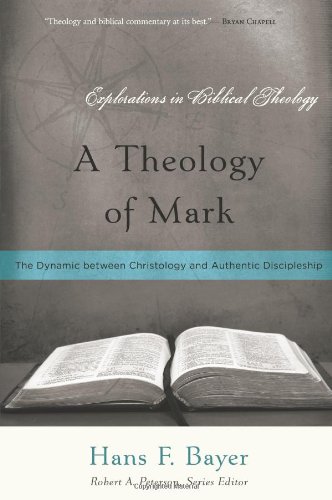A Brief Book Summary from Books At a Glance
About the Author
Hans F. Bayer (Ph.D., the University of Aberdeen) is Professor of New Testament and Chair of the New Testament Department at Covenant Theological Seminary in St. Louis, Missouri. He has ministry experience in Germany and in the US. He has taught at a number of seminaries. He has published a number of books and articles on the Gospel of Mark, both in English and German.
Introduction
In this book Bayer presents a theology of the Gospel of Mark that focuses on Christology and authentic discipleship. This theology is a biblical theology that focuses primarily on Mark’s Gospel with an eye to the rest of Scripture. This book fits the emphasis on demonstrating the practical and pastoral implications for biblical theology.
Table of Contents
Introduction
Part 1 Mark as Biography and Message of God’s Eternal Rule
Chapter 1 Mark as Biography and Memorized Witness Account
Chapter 2 Mark’s Structure, Purpose, and Flow of Thought
Chapter 3 Mark’s Thematic Framework: The In-Breaking of God’s Eternal Rule
Part 2 The Dynamic between God’s Messiah and Authentic Disciples
Chapter 4 Witness to the Unique Person of Jesus
Chapter 5 Jesus’ Fundamental Challenge to the Twelve and to All Disciples
Chapter 6 Christlike Character
Chapter 7 Eight Discipleship Qualities
Chapter 8 A Reciprocal Approach to Discipleship
Chapter 9 Following Mark’s Call in the Twenty-first Century
Conclusion
Appendix A Contemporary Challenges of—and answers to—the Origin and Formation of Mark’s Account
Summary
Chapter 1
Mark as Biography and Memorized Witness Account
Bayer begins this chapter by explaining how “form serves content.” That is, the form of the Gospels, the genre, affects how someone should read them. How one understands the genre of the Gospels affects how they read and, thus, apply them. Bayer begins his discussion of Mark’s theology with a discussion of genre. Bayer builds his definition of genre from Richard A. Burridge’s work What Are the Gospels? (1992) that claims that the Gospels fit the genre bioi. Writers used this genre primarily for describing the life of key persons mentioned at the beginning of the accounts. This genre was used for a number of purposes, of which the most important is perhaps its desire for its readers to emulate the character of the hero described. Bayer believes the same is true of Jesus in the Gospels.
Bayer also explains that Mark was a systematically memorized witness account. Bayer sets up the cultural background of this claim by detailing elementary school education in first-century Palestine by describing the schoolhouse, the teacher’s role, the student’s expectations, contents to be learned, and the methods of instruction. Bayer, then, shows the similarities and dissimilarities between that model and Jesus’.
Chapter 2
Mark’s Structure, Purpose, and Flow of Thought
In this chapter Bayer continues on his theme of “form serves content” by considering the structure, purpose, and flow of thought of Mark’s Gospel. Bayer outlines Mark’s Gospel with a three-part outline that follows Eduard Schweizer’s outline in “Mark’s Theological Achievement.” The outline goes with an introduction…
[To continue reading this summary, please see below....]The remainder of this article is premium content. Become a member to continue reading.
Already have an account? Sign In
Buy the books

A Theology of Mark